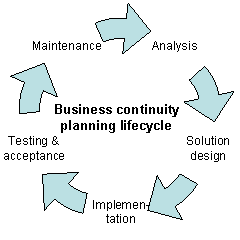
Business continuity may be defined as "the capability of an organization to continue the delivery of products or services at pre-defined acceptable levels following a disruptive incident", and business continuity planning is the process of creating systems of prevention and recovery to deal with potential threats to a company. In addition to prevention, the goal is to enable ongoing operations before and during execution of disaster recovery. Business continuity is the intended outcome of proper execution of both business continuity planning and disaster recovery.

The Directorate-General for European Civil Protection and Humanitarian Aid Operations, formerly known as the European Community Humanitarian Aid Office, is the European Commission's department for overseas humanitarian aid and for civil protection. It aims to save and preserve life, prevent and alleviate human suffering and safeguard the integrity and dignity of populations affected by natural disasters and man-made crises. Since September 2019, Janez Lenarčič is serving as Commissioner for Crisis Management in the Von der leyen commission, and since 1 March 2023, Maciej Popowski leads the organisation as the Director-General.

A humanitarian crisis is defined as a singular event or a series of events that are threatening in terms of health, safety or well-being of a community or large group of people. It may be an internal or external conflict and usually occurs throughout a large land area. Local, national and international responses are necessary in such events.

Emergency management is a science and a system charged with creating the framework within which communities reduce vulnerability to hazards and cope with disasters. Emergency management, despite its name, does not actually focus on the management of emergencies; emergency management or disaster management can be understood as minor events with limited impacts and are managed through the day-to-day functions of a community. Instead, emergency management focuses on the management of disasters, which are events that produce more impacts than a community can handle on its own. The management of disasters tends to require some combination of activity from individuals and households, organizations, local, and/or higher levels of government. Although many different terminologies exist globally, the activities of emergency management can be generally categorized into preparedness, response, mitigation, and recovery, although other terms such as disaster risk reduction and prevention are also common. The outcome of emergency management is to prevent disasters and where this is not possible, to reduce their harmful impacts.

The United Nations Office for the Coordination of Humanitarian Affairs (OCHA) is a United Nations (UN) body established in December 1991 by the General Assembly to strengthen the international response to complex emergencies and natural disasters. It is the successor to the Office of the United Nations Disaster Relief Coordinator (UNDRO).

Disaster response refers to the actions taken directly before, during, or immediately after a disaster. The objective is to save lives, ensure health and safety, and meet the subsistence needs of the people affected. It includes warning and evacuation, search and rescue, providing immediate assistance, assessing damage, continuing assistance, and the immediate restoration or construction of infrastructure. An example of this would be building provisional storm drains or diversion dams. Emergency response aims to provide immediate help to keep people alive, improve their health and support their morale. It can involve specific but limited aid, such as helping refugees with transport, temporary shelter, and food. Or it can involve establishing semi-permanent settlements in camps and other locations. It may also involve initial repairs to damage to infrastructure, or diverting it.

Disaster informatics or crisis informatics is the study of the use of information and technology in the preparation, mitigation, response and recovery phases of disasters and other emergencies. Disaster informatics or emergency involves increased use of technology to depict how people can react to emergencies and other disasters that require fast improvements on recovery and preparedness. It began to emerge as a field after the successful use of a variety of technologies in disasters including the Asian tsunami, September 11th and Hurricane Katrina.
A Humanitarian Information Centre (HIC) was a common service to the humanitarian community managed by the United Nations Office for the Coordination of Humanitarian Affairs (OCHA). HICs were operated in coordination with a number of partners which may include the United Nations Joint Logistics Centre (UNJLC), the Swedish Rescue Services Agency (SRSA), the European Community Humanitarian Office (ECHO), and the NGO MapAction.
There are a number of meanings for the term humanitarian. Here, humanitarian pertains to the practice of saving lives and alleviating suffering. It is usually related to emergency response whether in the case of a natural disaster or a man-made disaster such as war or other armed conflict. Humanitarian principles govern the way humanitarian response is carried out.

ReliefWeb (RW) is a humanitarian information portal founded in 1996. As of July 2023, it hosts more than one million humanitarian situation reports, press releases, evaluations, guidelines, assessments, maps and infographics. The portal is an independent source of information, designed specifically to assist the international humanitarian community in effective delivery of emergency assistance or relief. It provides information as humanitarian crises unfold, while emphasizing the coverage of "forgotten emergencies" at the same time.
An environmental emergency is defined as a "sudden-onset disaster or accident resulting from natural, technological or human-induced factors, or a combination of these, that causes or threatens to cause severe environmental damage as well as loss of human lives and property."
The International Search and Rescue Advisory Group (INSARAG) is a network of disaster-prone and disaster-responding countries and organizations dedicated to urban search and rescue (USAR) and operational field coordination. It aims to establish standards and classification for international USAR teams as well as a methodology for international response coordination in the aftermath of earthquakes and collapsed structure disasters. The INSARAG Secretariat is located in the United Nations Office for the Coordination of Humanitarian Affairs (OCHA) at the Palais des Nations in Geneva.
The Centre for Research on the Epidemiology of Disasters (CRED) is a research unit of the University of Louvain (UCLouvain). It is part of the School of Public Health located on the UCLouvain Brussels Woluwe campus, in Brussels, Belgium.

Although logistics has been mostly utilized in commercial supply chains, it is also an important tool in disaster relief operations. Humanitarian logistics is a branch of logistics which specializes in organizing the delivery and warehousing of supplies during natural disasters or complex emergencies to the affected area and people. However, this definition focuses only on the physical flow of goods to final destinations, and in reality, humanitarian logistics is far more complicated and includes forecasting and optimizing resources, managing inventory, and exchanging information. Thus, a good broader definition of humanitarian logistics is the process of planning, implementing and controlling the efficient, cost-effective flow and storage of goods and materials, as well as related information, from the point of origin to the point of consumption for the purpose of alleviating the suffering of vulnerable people.
The Emergency Data Exchange Language (EDXL) is a suite of XML-based messaging standards that facilitate emergency information sharing between government entities and the full range of emergency-related organizations. EDXL standardizes messaging formats for communications between these parties. EDXL was developed as a royalty-free standard by the OASIS International Open Standards Consortium.
A P-code, short for place code, is a kind of geocode used mostly by emergency response teams. It provides unique identifiers to thousands of locations and administrative units in a humanitarian operation. The p-codes are represented by combinations of letters and/or numbers to identify a specific location or feature on a map or within a database. These codes provide a systematic means of linking data to an unambiguous location. Any information that is tagged with P-codes can be combined and analyzed with any other p-coded data. The p-codes for a country can be found in the Common Operational Datasets, which are standard geographic references for the humanitarian community provided by UN OCHA:
The Emergency Capacity Building Project is a collaborative capacity-building project aimed at improving the speed, effectiveness and delivery of humanitarian response programs. The ECB Project is a partnership between seven non-governmental organizations (NGOs), and implements programs in one region and four countries known as consortia.

The Digital Humanitarian Network is a consortium allowing Volunteer and Technical Communities (V&TCs) to interface with humanitarian organizations that seek their services.

The Logistics Cluster is a coordination mechanism established by the Inter-Agency Standing Committee (IASC), activated to ensure an efficient and effective emergency response.

The United Nations World Humanitarian Summit (WHS) was held in Istanbul, Turkey, on May 23 and 24, 2016. The summit was an initiative of the Secretary-General of the United Nations Ban Ki-moon and was organized by the United Nations Office for the Coordination of Humanitarian Affairs.











